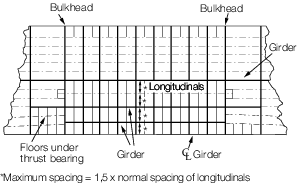4.1.1 The
minimum depth of the centre girder and its thickness are to be at
least the same as required in way of cargo space amidships, see
Pt 4, Ch 1, 8 Double bottom structure. A greater depth is recommended
in way of large engine-rooms when the variation in draught between
light and load conditions is considerable. For passenger ships, see
Pt 4, Ch 2, 6 Double bottom.
4.1.2 In machinery
spaces situated adjacent to the after peak, the double bottom is to
be transversely framed. Elsewhere transverse or longitudinal framing
may be adopted, but see also
Pt 4, Ch 1, 8 Double bottom structure.
4.1.3 Where
the double bottom is transversely framed, plate floors are to be fitted
at every frame in the engine-room. In way of boilers, plate floors
are to be fitted under the boiler bearers, and elsewhere as required
by Pt 4, Ch 1, 8 Double bottom structure.
4.1.4 Where
the double bottom is longitudinally framed, plate floors are to be
fitted at every frame under the main engines and thrust bearing. Outboard
of the engine seating, floors may be fitted at alternate frames, see
Figure 7.4.1 Engine-room with longitudinal framing.

Figure 7.4.1 Engine-room with longitudinal framing
4.1.6 Sufficient
fore and aft girders are to be arranged in way of the main machinery
to effectively distribute its weight and to ensure adequate rigidity
of the structure. In midship machinery spaces these girders are to
extend for the full length of the space and are to be carried aft
to support the foremost shaft tunnel bearing. This extension beyond
the after bulkhead of the engine-room is to be for at least three
transverse frame spaces, aft of which the girders are to scarf into
the structure. Forward of the engine-room bulkhead, the girders are
to be tapered off over three frame spaces and effectively scarfed
into the structure. In machinery spaces situated at the aft end the
girders are to be carried as far aft as practicable and the ends effectively
supported by web frames or transverses. For recommended scantlings
of engine girders, see
Pt 3, Ch 7, 6.2 Seats for engines 6.2.1.
4.1.7 Outboard
of the engines, side girders are to be arranged, where practicable,
to line up with the side girders in adjacent cargo spaces. These are
to have scantlings as required by Pt 4, Ch 1, 8 Double bottom structure.
4.1.8 Where
the double bottom is longitudinally framed and transverse floors are
fitted in way of the engine seatings as required by Pt 3, Ch 7, 4.1 Double bottom structure 4.1.4, no additional longitudinal
stiffening is required in way of the engines other than the main engine
girders, provided that the spacing of girders does not exceed 1,5
times the normal spacing of longitudinals. Where this spacing of girders
is exceeded, shell longitudinals are to be fitted. These are to scarf
into the longitudinal framing clear of the machinery spaces. The scantlings
of the longitudinals are to be determined as required by Pt 4, Ch 1, 6 Shell envelope framing using a minimum span of
1,3 m, see
Figure 7.4.1 Engine-room with longitudinal framing.
4.1.10 Where
the height of inner bottom in the machinery spaces differs from that
in adjacent spaces, continuity of longitudinal material is to be maintained
by sloping the inner bottom over an adequate longitudinal extent.
The knuckles in the plating are to be arranged close to plate floors.